Canadian Armed Forces ranks and insignia
This is a table of the ranks and insignia of the Canadian Armed Forces. As the Canadian Armed Forces is officially bilingual, the French language ranks are presented following the English (in italics).
Commander-in-Chief insignia
The Commander-in-Chief of the Canadian Armed Forces (French: Commandant en chef des Forces armées canadiennes) rank insignia is a special sleeve braid embellished with the crest of the Royal arms of Canada and this same embroidered crest is worn on the shoulder straps.[1]
The rank insignia for the Commander-in-Chief.
| Commander-in-Chief | ||
|---|---|---|
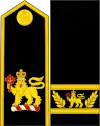 | ||
 | ||
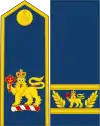 | ||
Officer rank insignia


The rank insignia for commissioned officers for the navy, army, and air force.
| NATO code | OF-10 | OF-9 | OF-8 | OF-7 | OF-6 | OF-5 | OF-4 | OF-3 | OF-2 | OF-1 | OF(D) | Student officer | ||||||||||||||||||||||||
|---|---|---|---|---|---|---|---|---|---|---|---|---|---|---|---|---|---|---|---|---|---|---|---|---|---|---|---|---|---|---|---|---|---|---|---|---|
_OF-9.svg.png.webp)  |
_OF-8.svg.png.webp)  |
_OF-7.svg.png.webp)  |
_OF-6.svg.png.webp)  |
 |
 |
 |
 |
 |
 |
 | ||||||||||||||||||||||||||
| Admiral | Vice-admiral | Rear-admiral | Commodore | Captain (N) | Commander | Lieutenant-commander | Lieutenant (N) | Sub-lieutenant | Acting sub-lieutenant | Naval cadet | ||||||||||||||||||||||||||
| Amiral | Vice-amiral | Contre-amiral | Commodore | Capitaine de vaisseau | Capitaine de frégate | Capitaine de corvette | Lieutenant de vaisseau | Enseigne de vaisseau de 1re classe | Enseigne de vaisseau de 2e classe | Aspirant de marine | ||||||||||||||||||||||||||
 |
 |
 |
 |
 |
 |
 |
 |
 |
 |
.svg.png.webp) | ||||||||||||||||||||||||||
| General | Lieutenant-general | Major-general | Brigadier-general | Colonel | Lieutenant-colonel | Major | Captain | Lieutenant | Second lieutenant | Officer cadet | ||||||||||||||||||||||||||
| Général | Lieutenant-général | Major-général | Brigadier-général | Colonel | Lieutenant-colonel | Major | Capitaine | Lieutenant | Sous-lieutenant | Élève-officier | ||||||||||||||||||||||||||
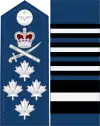 |
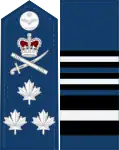 |
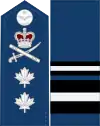 |
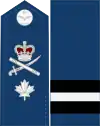 |
 |
 |
 |
 |
 |
 |
.svg.png.webp) |
||||||||||||||||||||||||||
| General | Lieutenant-general | Major-general | Brigadier-general | Colonel | Lieutenant-colonel | Major | Captain | Lieutenant | Second lieutenant | Officer cadet | ||||||||||||||||||||||||||
| Général | Lieutenant-général | Major-général | Brigadier-général | Colonel | Lieutenant-colonel | Major | Capitaine | Lieutenant | Sous-lieutenant | Élève-officier | ||||||||||||||||||||||||||
| NATO code | OF-10 | OF-9 | OF-8 | OF-7 | OF-6 | OF-5 | OF-4 | OF-3 | OF-2 | OF-1 | OF(D) | Student officer | ||||||||||||||||||||||||
Non-commissioned member (NCM) rank insignia
The following are the rank insignia for non-commissioned members for the navy, army and air force respectively.
NCM rank insignia for the rank of petty officer 1st class/warrant officer and above are worn on the lower sleeve, while those for the rank of petty officer 2nd class/sergeant and below are worn on the upper sleeve. The Royal Canadian Navy has directed its personnel to use the English rank titles for OR-1 through OR-5, but they are not yet legally in force pursuant to the National Defence Act, as they are not yet updated in the King's Regulations and Orders issued by the Governor-in-Council.[3]
| NATO code | OR-9 | OR-8 | OR-7 | OR-6 | OR-5 | OR-4 | OR-3 | OR-2 | OR-1 | |||||||||||||||||||||||||||
|---|---|---|---|---|---|---|---|---|---|---|---|---|---|---|---|---|---|---|---|---|---|---|---|---|---|---|---|---|---|---|---|---|---|---|---|---|
 |
 |
 |
 |
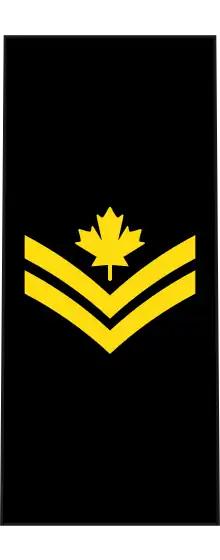 |
 |
 |
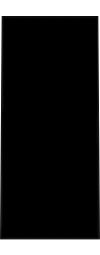 | |||||||||||||||||||||||||||||
| Chief petty officer 1st class | Chief petty officer 2nd class | Petty officer 1st class | Petty officer 2nd class | Master sailor | Sailor 1st class | Sailor 2nd class | Sailor 3rd class | |||||||||||||||||||||||||||||
| Premier maître de 1re classe | Premier maître de 2e classe | Maître de 1re classe | Maître de 2e classe | Matelot-chef | Matelot de 1re classe | Matelot de 2e classe | Matelot de 3e classe | |||||||||||||||||||||||||||||
 |
 |
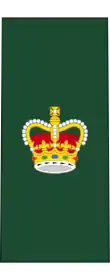 |
 |
 |
 |
 |
 | |||||||||||||||||||||||||||||
| Chief warrant officer | Master warrant officer | Warrant officer | Sergeant | Master corporal | Corporal | Private (trained) | Private (basic) | |||||||||||||||||||||||||||||
| Adjudant-chef | Adjudant-maître | Adjudant | Sergent | Caporal-chef | Caporal | Soldat (formé) | Soldat (confirmé) | |||||||||||||||||||||||||||||
 |
 |
 |
 |
 |
 |
 |
 | |||||||||||||||||||||||||||||
| Chief warrant officer | Master warrant officer | Warrant officer | Sergeant | Master corporal | Corporal | Aviator (trained) | Aviator (basic) | |||||||||||||||||||||||||||||
| Adjudant-chef | Adjudant-maître | Adjudant | Sergent | Caporal-chef | Caporal | Aviateur (formé) | Aviateur (confirmé) | |||||||||||||||||||||||||||||
| NATO code | OR-9 | OR-8 | OR-7 | OR-6 | OR-5 | OR-4 | OR-3 | OR-2 | OR-1 | |||||||||||||||||||||||||||
Appointments
The rank insignia for NCM appointments.
| Rank group | Senior appointments | Appointments | ||||
 |
 |
 |
 |
 |
 | |
| Canadian Forces Chief Warrant Officer | Command chief petty officer | Senior appointment Chief petty officer, 1st class | Drum major | Pipe major | Trumpet / Bugle major | |
| Adjudant-chef des Forces canadiennes | Premier maître de 1re classe du commandement |
Premier maître de 1re classe | Tambour-major | Cornemuseur-major | Trompette / Clairon-major | |
 |
 |
 |
 |
 |
 | |
| Canadian Forces Chief Warrant Officer | Command chief warrant officer | Senior Appointment Chief Warrant Officer | Drum major | Pipe major | Trumpet / Bugle major | |
| Adjudant-chef des Forces canadiennes | Adjudant-chef du commandement | Adjudant-chef-nomination supérieure | Tambour-major | Cornemuseur-major | Trompette / Clairon-major | |
 |
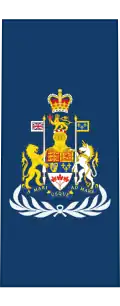 |
 |
 |
 |
 | |
| Canadian Forces Chief Warrant Officer | Command chief warrant officer | Senior Appointment Chief Warrant Officer |
Drum major | Pipe major | Trumpet / Bugle major | |
| Adjudant-chef des Forces canadiennes | Adjudant-chef du commandement | Adjudant-chef-nomination supérieure | Tambour-major | Cornemuseur-major | Trompette / Clairon-major | |
| Rank group | Senior appointments | Appointments | ||||
Rank slip-ons
The tables above describe the rank insignia worn on the service dress jacket. On DEU shirts, sweaters, and outerwear; and operational dress shirts and jackets, rank insignia are worn on slip-ons with the word "CANADA" or a regimental/branch title embroidered underneath. Flag/general officers' slip-ons include only the crown, crossed sabre and baton, and maple leaves worn on the shoulder straps; they do not include the braid worn on the sleeve. Army NCM slip-ons for DEU shirts, sweaters, and outerwear display only the word "CANADA" or a regimental/branch title, rank insignia being worn instead as enamelled metal pins on collar points or lapels.
Service stripes
From 1955 to 1968, Militia personnel were permitted to wear service insignia on the right jacket sleeve.[4][5] There were one to five silver chevrons on drab backing for every two years of service or a maple leaf in silver thread on a drab cloth circle to represent 10 years of service. Chevron points were worn either up or down; even official documents and photos were confused on the matter. Further awards after 10 years were believed covered by the Canadian Forces Decoration, which was awarded after 12 years and a clasp added for every 10 years afterwards.
Qualifying service could include prior active service in the active reserves of the Royal Canadian Navy and Royal Canadian Air Force or the regular or territorial forces of a fellow Commonwealth member nation. Service in Canadian Army reserve forces units (like the regular reserve, supplementary reserve and reserve militia) did not count. The awarding of Service Stripes ceased in 1968 after the unification of the Canadian Armed Forces.
Canadian Army distinctive corps insignia
Every branch or corps of the Canadian Army uses a distinctive colour. Applicable only to officers, they are indicated by coloured borders of rank insignia on DEU shirt and sweater slip-ons and on mess dress.[6][7][8]
| Branch | Colour | Image |
|---|---|---|
| Royal Canadian Armoured Corps | Yellow | |
| Red | ||
| Blue | ||
|
Scarlet | |
| Royal Canadian Medical Service | Dull cherry | |
| Canadian Intelligence Corps | Forest green (silver rank) | |
| Royal Canadian Dental Corps | Emerald green | |
| Royal Canadian Chaplain Service | Purple | |
| RCIC members of Les Voltigeurs de Québec | Black |
Distinctive rank names
Some branches and regiments use distinctive job titles for privates (trained) in those regiments:
| Branch | Distinct title |
|---|---|
| Royal Canadian Armoured Corps | Trooper (cavalier) |
| Royal Regiment of Canadian Artillery | Gunner (artilleur) |
| Corps of Royal Canadian Engineers | Sapper (sapeur) |
| Royal Canadian Corps of Signals | Signaller (signaleur) |
| Corps of Royal Canadian Electrical and Mechanical Engineers | Craftsman (artisan) |
| Royal Canadian Infantry Corps (RCIC) members of guards regiments | Guardsman (garde) |
| RCIC members of rifle regiments | Rifleman (carabinier) |
| RCIC members of fusilier regiments | Fusilier (fusilier) |
| RCIC members of voltigeur regiment | Voltigeur (voltigeur) |
| Musicians of the Music Branch | Musician (musicien) |
| Pipers of the Music Branch | Piper (cornemuseur) |
| Drummers of the Music Branch | Drummer (batteur) |
| Canadian Rangers | Ranger (ranger) |
Additionally, the Royal Regiment of Canadian Artillery uses "bombardier" for corporals and "master bombardier" for master corporal. In the Guard regiments, warrant officers are known as "colour sergeants" and second lieutenants are known as "ensigns".
Evolution of Royal Canadian Navy rank and insignia
When the Royal Canadian Navy was established in 1910, it kept with Royal Navy traditions and adopted sleeve braid with an executive curl for rank insignia. "Wavy" sleeve braid was adopted for the Royal Canadian Naval Volunteer Reserve (RCNVR) and rings of narrow interwoven gold lace for the Royal Canadian Navy Reserve (RCNR). Other variations in rank insignia included sky blue lace with a diamond shaped loop for officers of the Women's Royal Canadian Naval Service, and warranted Royal Canadian Sea Cadet Corps officers, who had a small anchor in place of the executive curl.
Following the Second World War, the Royal Canadian Navy was reorganized with a single reserve component. In 1946, the distinctive wavy gold braid of the reserves gave way to the straight braided executive curl of the regular force until 1968. With the integration of the Canadian Forces the sea element was designated as Canadian Forces Maritime Command. Unembellished straight braid became the common rank insignia for officers of both the regular and reserve forces. The executive curl appeared only on navy mess dress.
On 5 March 2010, the Canadian House of Commons passed a motion (moved by Guy Lauzon[9]) recommending the executive curl be reinstated on the Canadian navy uniform. Subsequently, in recognition of the Canadian Naval centennial, Peter MacKay, Minister of National Defence, authorized the use of the executive curl for the Canadian Navy on 2 May 2010. The insignia became effective on 11 June 2010, on the occasion of the Pacific Canadian Naval International Fleet Review parade of nations in Victoria, B.C.[10][11]
More than 54 countries, including Canada and 18 other of the 22 Commonwealth navies, use the insignia. Most navies that do not use the executive curl insignia, such as the United States Navy and the French Navy, substitute a star or other national device above the top row of lace.
Timeline of changes (sleeves only)
| Rank group | General / flag officers | Senior officers | Junior officers | Officer cadet | ||||||||||||||||||||||||||||||||
|---|---|---|---|---|---|---|---|---|---|---|---|---|---|---|---|---|---|---|---|---|---|---|---|---|---|---|---|---|---|---|---|---|---|---|---|---|
| Royal Canadian Navy (1910–1968) |
 |
 |
 |
 |
 |
 |
 |
 |
 |
 |
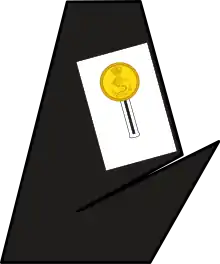 | |||||||||||||||||||||||||
| Maritime Command (1968–1985) |
 |
 |
 |
 |
_OF-5.svg.png.webp) |
_OF-4.svg.png.webp) |
_OF-3.svg.png.webp) |
_OF-2.svg.png.webp) |
_OF-1b.svg.png.webp) |
_OF-1a.svg.png.webp) |
_OF_(D).svg.png.webp) | |||||||||||||||||||||||||
| Maritime Command (1985–2010) |
 |
 |
 |
 |
_OF-5.svg.png.webp) |
_OF-4.svg.png.webp) |
_OF-3.svg.png.webp) |
_OF-2.svg.png.webp) |
_OF-1b.svg.png.webp) |
_OF-1a.svg.png.webp) |
_OF_(D).svg.png.webp) | |||||||||||||||||||||||||
| Royal Canadian Navy (Present) |
 |
 |
 |
 |
 |
 |
 |
 |
 |
 |
.svg.png.webp) | |||||||||||||||||||||||||
| Rank titles | Admiral | Vice-Admiral | Rear-Admiral | Commodore | Captain(N) | Commander | Lieutenant-Commander | Lieutenant(N) | Sub-Lieutenant | Acting Sub-Lieutenant | Naval cadet | |||||||||||||||||||||||||
| Amiral | Vice-amiral | Contre-amiral | Commodore | Capitaine de vaisseau | Capitaine de frégate | Capitaine de corvette | Lieutenant de vaisseau | Enseigne de vaisseau de première classe | Enseigne de vaisseau de deuxième classe | Aspirant de marine | ||||||||||||||||||||||||||
| NATO code | OF-10 | OF-9 | OF-8 | OF-7 | OF-6 | OF-5 | OF-4 | OF-3 | OF-2 | OF-1 | OF(D) | Student officer | ||||||||||||||||||||||||
| Rank group | Senior NCOs | Junior NCOs | Enlisted | |||||||||||||||||||||||||||||||||
|---|---|---|---|---|---|---|---|---|---|---|---|---|---|---|---|---|---|---|---|---|---|---|---|---|---|---|---|---|---|---|---|---|---|---|---|---|
| Royal Canadian Navy (1953–1968) |
 |
 |
 |
 |
Trade badge | No insignia | No insignia | |||||||||||||||||||||||||||||
| Chief petty officer 1st class Premier maître de 1re classe |
Chief petty officer 2nd class Premier maître de 2e classe |
Petty officer 1st class Maître de 1re classe |
Petty officer 2nd class Maître de 2e classe |
Leading seaman Matelot de 1re classe |
Able seaman Matelot de 2e classe |
Ordinary seaman Matelot de 3e classe |
Recruit Recrue | |||||||||||||||||||||||||||||
| Maritime Command (1968–1973) |
 |
 |
 |
 |
 |
.svg.png.webp) |
.svg.png.webp) |
 | ||||||||||||||||||||||||||||
| Maritime Command (1973–1985) |
 |
 |
 |
 |
 |
 |
 |
 | ||||||||||||||||||||||||||||
| Rank titles (1968–1985) |
Chief petty officer 1st class Premier maître de 1re classe |
Chief petty officer 2nd class Premier maître de 2e classe |
Petty officer 1st class Maître de 1re classe |
Petty officer 2nd class Maître de 2e classe |
Master seaman Matelot-chef |
Leading seaman Matelot de 1re classe |
Able seaman Matelot de 2e classe |
Ordinary seaman Matelot de 3e classe | ||||||||||||||||||||||||||||
| Maritime Command (1985–2010) |
 |
 |
 |
 |
 |
 |
 |
 | ||||||||||||||||||||||||||||
| Chief petty officer 1st class Premier maître de 1re classe |
Chief petty officer 2nd class Premier maître de 2e classe |
Petty officer 1st class Maître de 1re classe |
Petty officer 2nd class Maître de 2e classe |
Master seaman Matelot-chef |
Leading seaman Matelot de 1re classe |
Able seaman Matelot de 2e classe |
Ordinary seaman Matelot de 3e classe | |||||||||||||||||||||||||||||
| Royal Canadian Navy (2011–present) |
 |
 |
 |
 |
 |
 |
 |
 | ||||||||||||||||||||||||||||
| Rank titles (2011–2020) |
Chief petty officer 1st class Premier maître de 1re classe |
Chief petty officer 2nd class Premier maître de 2e classe |
Petty officer 1st class Maître de 1re classe |
Petty officer 2nd class Maître de 2e classe |
Master seaman Matelot-chef |
Leading seaman Matelot de 1re classe |
Able seaman Matelot de 2e classe |
Ordinary seaman Matelot de 3e classe | ||||||||||||||||||||||||||||
| Rank titles (2020–present) |
Chief petty officer 1st class Premier maître de 1re classe |
Chief petty officer 2nd class Premier maître de 2e classe |
Petty officer 1st class Maître de 1re classe |
Petty officer 2nd class Maître de 2e classe |
Master sailor Matelot-chef |
Sailor 1st class Matelot de 1re classe |
Sailor 2nd class Matelot de 2e classe |
Sailor 3rd class Matelot de 3e classe | ||||||||||||||||||||||||||||
| NATO code | OR-9 | OR-8 | OR-7 | OR-6 | OR-5 | OR-4 | OR-3 | OR-2 | OR-1 | |||||||||||||||||||||||||||
Evolution of Canadian Army ranks and insignia
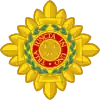
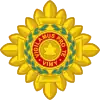
Prior to unification in 1968, the Canadian Army used rank insignia identical to the British Army. When the universal CF green uniform was adopted at unification, Land Command, like the other services, used gold braid sleeve stripes as rank insignia. When distinctive environmental uniforms were adopted in the mid-1980s, the army retained the green uniform with gold stripes.
On 8 July 2013, Minister of National Defence Peter MacKay announced the intention to reintroduce a more traditional style Canadian Army officers' rank insignia.[12] Instead of the sleeve stripe rank insignia used since unification, officers would use the older St Edward's Crown and Star of the Order of the Bath insignia, commonly called "pips and crowns".[13] Gorget patches were also restored for officers of the rank of colonel or higher.[14] The new insignia for officers, instead of using the current British rank insignia for brigadier (used in the Canadian Army until 1968), had the pre-1920 brigadier-general insignia (crossed sabre and baton) instead.
On 2 April 2016, the Commander of the Canadian Army announced that general officers would revert to the unification-era rank insignia worn between 1968 and 2013. This rank insignia is based on the shoulder board rank insignia of Royal Canadian Navy flag officers. The rank insignia of general officers now consists of a crown, crossed sabre and baton, and a series of maple leaves on shoulder straps. Additionally, general officers wear one broad gold band on each of the lower sleeves of the service dress tunic.[15]
On the centenary of the Battle of Vimy Ridge, 9 April 2017, the Bath Star pip was replaced by the "Vimy Star". It depicts a maple leaf and is surrounded by the Latin motto vigilamus pro te ("we stand on guard for thee"). Commissioned officers of the household guard regiments (Governor General's Foot Guards, Canadian Grenadier Guards, and Governor General's Horse Guards), plus Army personnel stationed to the seasonal Ceremonial Guard, use the Guards Star in place of the Vimy Star on their shoulder boards.
Timeline of changes
| Rank group | General / flag officers | Senior officers | Junior officers | Officer cadet | ||||||||||||||||||||||||||||||||
|---|---|---|---|---|---|---|---|---|---|---|---|---|---|---|---|---|---|---|---|---|---|---|---|---|---|---|---|---|---|---|---|---|---|---|---|---|
| Canadian Militia (1902–1920) Canadian Expeditionary Force (1914–1920) |
_OF-9.svg.png.webp) |
_OF-8.svg.png.webp) |
_OF-7.svg.png.webp) |
_OF-6.svg.png.webp) |
_OF-5.svg.png.webp) |
_OF-4.svg.png.webp) |
_OF-3.svg.png.webp) |
_OF-2.svg.png.webp) |
_OF-1b.svg.png.webp) |
_OF-1a.svg.png.webp) |
||||||||||||||||||||||||||
| General | Lieutenant-General | Major-General | Brigadier-General | Colonel | Lieutenant-Colonel | Major | Captain | Lieutenant | Second Lieutenant | Officer Cadet | ||||||||||||||||||||||||||
| Canadian Militia (1921–1940) Canadian Army (1940–1953) |
_OF-9.svg.png.webp) |
_OF-8.svg.png.webp) |
_OF-7.svg.png.webp) |
_OF-6.svg.png.webp) |
_OF-5.svg.png.webp) |
_OF-4.svg.png.webp) |
_OF-3.svg.png.webp) |
_OF-2.svg.png.webp) |
_OF-1b.svg.png.webp) |
_OF-1a.svg.png.webp) |
_OF_(D).svg.png.webp) | |||||||||||||||||||||||||
| General | Lieutenant-General | Major-General | Colonel commandant | Colonel | Lieutenant-Colonel | Major | Captain | Lieutenant | Second Lieutenant | Officer Cadet | ||||||||||||||||||||||||||
| Canadian Army (1953–1968)[16] |
 |
 |
 |
 |
 |
 |
 |
 |
 |
 |
_(1953%E2%80%931968).svg.png.webp) | |||||||||||||||||||||||||
| General | Lieutenant-general | Major-general | Brigadier | Colonel | Lieutenant-colonel | Major | Captain | Lieutenant | Second lieutenant | Officer cadet | ||||||||||||||||||||||||||
| Mobile Command & Land Force Command (1968–2013) |
 |
 |
 |
 |
_OF-5.svg.png.webp) |
_OF-4.svg.png.webp) |
_OF-3.svg.png.webp) |
_OF-2.svg.png.webp) |
_OF-1b.svg.png.webp) |
_OF-1a.svg.png.webp) |
_OF_(D).svg.png.webp) | |||||||||||||||||||||||||
| Canadian Army (2013–2016) |
_OF-9.svg.png.webp) |
_OF-8.svg.png.webp) |
_OF-7.svg.png.webp) |
_OF-6.svg.png.webp) |
.svg.png.webp) |
.svg.png.webp) |
 |
.svg.png.webp) |
.svg.png.webp) |
.svg.png.webp) |
_(2016-2017).svg.png.webp) | |||||||||||||||||||||||||
| Canadian Army (2016–2017) |
 |
 |
 |
 |
.svg.png.webp) |
.svg.png.webp) |
 |
.svg.png.webp) |
.svg.png.webp) |
.svg.png.webp) |
_(2016-2017).svg.png.webp) | |||||||||||||||||||||||||
| Canadian Army (Present) |
 |
 |
 |
 |
 |
 |
 |
 |
 |
 |
.svg.png.webp) | |||||||||||||||||||||||||
| Rank titles | General | Lieutenant-General | Major-General | Brigadier-General | Colonel | Lieutenant-Colonel | Major | Captain | Lieutenant | Second Lieutenant | Officer Cadet | |||||||||||||||||||||||||
| Général | Lieutenant-général | Major-général | Brigadier-général | Colonel | Lieutenant-colonel | Major | Capitaine | Lieutenant | Sous-lieutenant | Élève-officier | ||||||||||||||||||||||||||
| NATO code | OF-10 | OF-9 | OF-8 | OF-7 | OF-6 | OF-5 | OF-4 | OF-3 | OF-2 | OF-1 | OF(D) | Student officer | ||||||||||||||||||||||||
| Rank group | Senior NCOs | Junior NCOs | Enlisted | |||||||||||||||||||||||||||||||||
|---|---|---|---|---|---|---|---|---|---|---|---|---|---|---|---|---|---|---|---|---|---|---|---|---|---|---|---|---|---|---|---|---|---|---|---|---|
| (1920–1953) | _OR-9a.svg.png.webp) |
_OR-8.svg.png.webp) |
_OR-7.svg.png.webp) |
_OR-6.svg.png.webp) |
_OR-4.svg.png.webp) |
_OR-3.svg.png.webp) |
_OR-2.svg.png.webp) |
No insignia | ||||||||||||||||||||||||||||
| Warrant Officer Class I | Warrant Officer Class II | Staff/Colour Sergeant | Sergeant | Corporal | Lance Corporal | Private (or equivalent) | ||||||||||||||||||||||||||||||
| Canadian Army (1953–1966)[16] |
.svg.png.webp) |
 |
 |
 |
 |
No insignia | ||||||||||||||||||||||||||||||
| Warrant Officer Class I/1 | Warrant Officer Class II/2 | Staff/Colour Sergeant | Sergeant | Corporal | Lance Corporal | Private (or equivalent) | ||||||||||||||||||||||||||||||
| Canadian Army (1966–1968) |
.svg.png.webp) |
 |
 |
 |
 |
.svg.png.webp) |
No insignia | |||||||||||||||||||||||||||||
| Warrant Officer Class I/1 | Warrant Officer Class II/2 | Staff/Colour Sergeant | Sergeant | Master corporal | Corporal | Lance Corporal | Private (or equivalent) | |||||||||||||||||||||||||||||
| Land Force Command (1968–1973) |
 |
 |
 |
 |
 |
.svg.png.webp) |
.svg.png.webp) |
 | ||||||||||||||||||||||||||||
| Land Force Command (1973–Present) |
 |
 |
 |
 |
 |
 |
 |
 | ||||||||||||||||||||||||||||
| Rank titles (1968–present) |
Chief warrant officer | Master warrant officer | Warrant officer | Sergeant | Master corporal | Corporal | Private | Private (basic) | ||||||||||||||||||||||||||||
| Adjudant-chef | Adjudant-maître | Adjudant | Sergent | Caporal-chef | Caporal | Soldat | Soldat (Confirmé) | |||||||||||||||||||||||||||||
| NATO code | OR-9 | OR-8 | OR-7 | OR-6 | OR-5 | OR-4 | OR-3 | OR-2 | OR-1 | |||||||||||||||||||||||||||
Evolution of Royal Canadian Air Force rank and insignia
Canadian Air Force ranks and insignia originally were taken from the Royal Air Force practice. Upon unification, the Air Command used identical ranks and insignia as the Land Command. When Air-specific blue DEUs were introduced, the gold rank insignia were retained.
In April 2015,[17] the Royal Canadian Air Force adopted new rank insignia reminiscent of the pre-unification RCAF system. The new officer rank insignia uses pearl-grey-on-black rank stripes instead of gold. Non-commissioned members (NCMs) rank insignia is pearl grey instead of gold. The colour gold found elsewhere on the uniform was also changed to pearl-grey. The air force rank of private, formerly indicated by one chevron, became aviator (Fr: aviateur), and is indicated by a horizontally-aligned two-bladed propeller. All other ranks titles remain as they were.[18]
Timeline of changes
| Rank group | General / flag officers | Senior officers | Junior officers | Officer cadet | ||||||||||||||||||||||||||||||||
|---|---|---|---|---|---|---|---|---|---|---|---|---|---|---|---|---|---|---|---|---|---|---|---|---|---|---|---|---|---|---|---|---|---|---|---|---|
| Royal Canadian Air Force (1924–1968)[16] |
 |
 |
 |
 |
 |
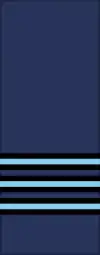 |
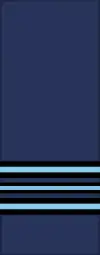 |
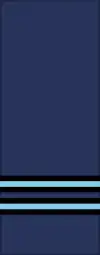 |
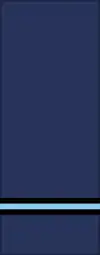 |
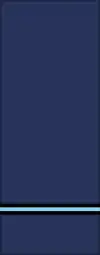 |
 | |||||||||||||||||||||||||
| Rank titles (1924–1968)[19][20] |
Air chief marshal | Air marshal | Air vice-marshal | Air commodore | Group captain | Wing commander | Squadron leader | Flight lieutenant | Flying officer | Pilot officer | Flight cadet/ officer cadet (post-1962) | |||||||||||||||||||||||||
| Maréchal en chef de l’Air | Maréchal de l’Air | Vice-maréchal de l’Air | Commodore de l’Air | Colonel d’aviation | Lieutenant-colonel d’aviation | Commandant d’aviation | Capitaine d’aviation | Lieutenant d’aviation | Sous-lieutenant d’aviation | Élève-officier | ||||||||||||||||||||||||||
| Air Command (1968–1984) |
 |
 |
 |
 |
_OF-5.svg.png.webp) |
_OF-4.svg.png.webp) |
_OF-3.svg.png.webp) |
_OF-2.svg.png.webp) |
_OF-1b.svg.png.webp) |
_OF-1a.svg.png.webp) |
_OF_(D).svg.png.webp) | |||||||||||||||||||||||||
| Air Command (1984–2014) |
_OF-9.svg.png.webp) |
_OF-8.svg.png.webp) |
_OF-7.svg.png.webp) |
_OF-6.svg.png.webp) |
_OF-5.svg.png.webp) |
_OF-4.svg.png.webp) |
_OF-3.svg.png.webp) |
_OF-2.svg.png.webp) |
_OF-1b.svg.png.webp) |
_OF-1a.svg.png.webp) |
_OF_(D).svg.png.webp) | |||||||||||||||||||||||||
| Royal Canadian Air Force (2014–present)[20] |
 |
 |
 |
 |
 |
 |
 |
 |
 |
 |
.svg.png.webp) | |||||||||||||||||||||||||
| Rank titles (1968–present) |
General | Lieutenant-general | Major-general | Brigadier-general | Colonel | Lieutenant-colonel | Major | Captain | Lieutenant | Second lieutenant |
Officer cadet | |||||||||||||||||||||||||
| Général | Lieutenant-général | Major-général | Brigadier-général | Colonel | Lieutenant-colonel | Major | Capitaine | Lieutenant | Sous-lieutenant | Élève-officier | ||||||||||||||||||||||||||
| NATO code | OF-10 | OF-9 | OF-8 | OF-7 | OF-6 | OF-5 | OF-4 | OF-3 | OF-2 | OF-1 | OF(D) | Student officer | ||||||||||||||||||||||||
| Rank group | Senior NCOs | Junior NCOs | Enlisted | |||||||||||||||||||||||||||||||||
|---|---|---|---|---|---|---|---|---|---|---|---|---|---|---|---|---|---|---|---|---|---|---|---|---|---|---|---|---|---|---|---|---|---|---|---|---|
| Air Force (1948–1953) |
 |
 |
 |
No insignia | ||||||||||||||||||||||||||||||||
| Air Force (1953–1968)[16] |
 |
 |
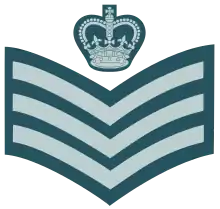 |
 |
No insignia | |||||||||||||||||||||||||||||||
| Rank titles (1948–1968)[19] |
Warrant officer first class | Warrant officer second class | Flight sergeant | Sergeant | Corporal | Leading aircraftman/aircraftwoman | Aircraftman/Aircraftwoman first class | Aircraftman/Aircraftwoman second class | ||||||||||||||||||||||||||||
| Adjudant de 1re classe | Adjudant de 2e classe | Sergent de section | Sergent | Caporal | Aviateur-chef | Aviateur 1re classe | Aviateur 2e classe | |||||||||||||||||||||||||||||
| Air Command (1968–1973) |
 |
 |
 |
 |
 |
.svg.png.webp) |
.svg.png.webp) |
 | ||||||||||||||||||||||||||||
| Air Command (1973–1984) |
 |
 |
 |
 |
 |
 |
 |
 | ||||||||||||||||||||||||||||
| Air Command (1984–2014) |
_OR-9.svg.png.webp) |
_OR-8.svg.png.webp) |
_OR-7.svg.png.webp) |
_OR-6.svg.png.webp) |
_OR-5.svg.png.webp) |
_OR-4.svg.png.webp) |
_OR-3.svg.png.webp) |
 | ||||||||||||||||||||||||||||
| Rank titles (1968–2014) |
Chief warrant officer | Master warrant officer | Warrant officer | Sergeant | Master corporal | Corporal | Private | Private (basic) | ||||||||||||||||||||||||||||
| Adjudant-chef | Adjudant-maître | Adjudant | Sergent | Caporal-chef | Caporal | Soldat | Soldat (confirmé) | |||||||||||||||||||||||||||||
| Royal Canadian Air Force (2014–present)[20] |
 |
 |
 |
 |
 |
 |
 |
 | ||||||||||||||||||||||||||||
| Rank titles (2014–present) |
Chief warrant officer | Master warrant officer | Warrant officer | Sergeant | Master corporal | Corporal | Aviator | Aviator (basic) | ||||||||||||||||||||||||||||
| Adjudant-chef | Adjudant-maître | Adjudant | Sergent | Caporal-chef | Caporal | Aviateur | Aviateur (confirmé) | |||||||||||||||||||||||||||||
| NATO code | OR-9 | OR-8 | OR-7 | OR-6 | OR-5 | OR-4 | OR-3 | OR-2 | OR-1 | |||||||||||||||||||||||||||
Mess dress
Contrary to the Royal Canadian Navy and the Canadian Army, mess dress uniform ranks for officers of the Royal Canadian Air Force follow the naval pattern, without the executive curl. General officers do not wear shoulder straps with this order of dress.
| NATO Code | OF-10 | OF-9 | OF-8 | OF-7 | OF-6 | OF-5 | OF-4 | OF-3 | OF-2 | OF-1 | OF(D) | Student officer | |
|---|---|---|---|---|---|---|---|---|---|---|---|---|---|
| Royal Canadian Air Force Mess dress and full dress[lower-alpha 1] ranks 1925-1968[22] |
 |
 |
 |
 |
_OF-5.svg.png.webp) |
_OF-4.svg.png.webp) |
_OF-3.svg.png.webp) |
_OF-2.svg.png.webp) |
_OF-1a.svg.png.webp) |
_OF_(D).svg.png.webp) |
_OF_(D).svg.png.webp) | ||
| Air Command Mess ranks 1968-2014 |
_OF-9.svg.png.webp) |
_OF-8.svg.png.webp) |
_OF-7.svg.png.webp) |
_OF-6.svg.png.webp) |
_OF-5.svg.png.webp) |
_OF-4.svg.png.webp) |
_OF-3.svg.png.webp) |
_OF-2.svg.png.webp) |
_OF-1b.svg.png.webp) |
_OF-1a.svg.png.webp) |
_OF_(D).svg.png.webp) | ||
| Royal Canadian Air Force Mess ranks since 2015 |
 |
 |
 |
 |
_OF-5.svg.png.webp) |
_OF-4.svg.png.webp) |
_OF-3.svg.png.webp) |
_OF-2.svg.png.webp) |
_OF-1b.svg.png.webp) |
_OF-1a.svg.png.webp) |
_OF_(D).svg.png.webp) | ||
See also
Notes
- The wearing of full dress and mess dress by RCAF officers was suspended "for the duration of hostilities" on 30 August 1940. Full dress was not reinstated after the war.[21]
References
- Department of National Defence, Canadian Forces Dress Instructions (PDF), Queen's Printer for Canada, pp. 3–7–3, archived from the original (PDF) on 21 July 2011, retrieved 15 November 2010
- "Ranks and appointment". canada.ca. Government of Canada. Retrieved 28 May 2021.
- Department of National Defence (8 August 2014). "QR&O: Volume I – Chapter 3 Rank, Seniority, Command and Precedence". aem. Retrieved 2 October 2020.
- "Service Stripes".
- Grimshaw, Lou (Spring 1997). "Military Collector's Club of Canada Journal".
{{cite journal}}: Cite journal requires|journal=(help) - 11110-1 (G7-4), 26 February 2014, OPERATION ORDER – CANADIAN ARMY IDENTITY B. CAO 33-19 – PUBLIC FUNDING TO RESTORE CA CORPS' IDENTITIES
- CAO 33-19 – PUBLIC FUNDING TO RESTORE CA CORPS' IDENTITIES
- CFSS Materiel Authorization (D01102CFS) – ARMY- BASIC CLOTH REGULAR & RESERVE, 20161005
- "Guy Lauzon on Canadian Navy". Hansard. 5 March 2010. Retrieved 10 January 2011.
- Marotte, B. (3 May 2010). "Navy celebrates centennial by restoring historic insignia". The Globe and Mail. Retrieved 20 June 2010.
- Department of National Defence. "Photo of the day archive". Archived from the original on 9 June 2011. Retrieved 20 June 2010.
- "Canada restores historical features of the Canadian Army". Department of National Defence. 8 July 2013. Archived from the original on 14 July 2013. Retrieved 25 July 2013.
- "Restoring the Canadian Army's historical identity". The Department of National Defence. 8 July 2013. Archived from the original on 14 July 2013. Retrieved 25 July 2013.
- Pugliese, David (8 July 2013). "Government Intends To Restore Canadian Army Rank Insignia, Names and Badges To Their Traditional Forms". The Ottawa Citizen. Archived from the original on 14 July 2013. Retrieved 25 July 2013.
- "Canadian Army Announces Changes to the General Officer Rank Insignia". Department of National Defence. 2 April 2016. Retrieved 15 December 2017.
- United States Department of the Army (1962). "Military Uniforms – DA Pam 355-120 – 1959 to 1962 – Part 2". Retrieved 9 October 2021.
- Pugliese, David (24 September 2014). "New RCAF Insignia and rank colours not available until March 2015". Ottawa Citizen. Retrieved 24 September 2014.
- unknown (21 September 2014). "New Uniform for the Royal Canadian Air Force". Government of Canada. Retrieved 24 September 2014.
- "A return to the Royal Canadian Air Force ranks: A historical examination". Government of Canada. 26 September 2014. Retrieved 19 October 2022.
- "New insignia for the Royal Canadian Air Force". Government of Canada. 24 September 2014. Retrieved 19 October 2022.
- Quigley, George (2007). "Dress Regulations for the Royal Canadian Air Force 1925 (1939) CAP 6 – 2nd Edition (Reprinted 1939 with amendments up to and including G.O. 171 of 1939) Composite Copy". RCAF Dress Regulations. Toronto: Service Publications. ISBN 1-894581-45-8.
- Quigley, George (2007). "Dress Regulations for the Royal Canadian Air Force 1925 CAP 6 – 1st Edition Composite Copy". RCAF Dress Regulations. Toronto: Service Publications. ISBN 1-894581-45-8.
External links
- Canadian Armed Forces ranks and appointment insignia – official site with images of rank insignia for Navy, Army and Air Force.